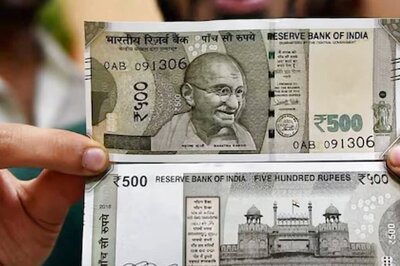
views
New Delhi: The recent tragedy of encephalitis-related deaths of children in Bihar has brought the national focus to the health infrastructure in the country. The Indian Medical Association (IMA) has complained about the lack of adequate funding in the 2019 Union Budget with regards to health. Rajiv Chhibber, a leading expert in public health communication and the Vice-President of External Affairs at Sahajanand Medical Technologies, speaks about what this entails for the health sector.
Excerpts from an interview:
Is the budgetary allocation to health sector sufficient?
The Union Budget of Modi 2.0 hardly had any mention of healthcare and flagship schemes were not even mentioned, apart from a passing reference to the sector that was almost a similar vision presented in the interim Budget in February. The Union Finance Minister did say that a healthy society would remain an area of attention for the government, which she attributed to factors like Ayushman Bharat and well-nourished children and women. The budgetary allocation for the Department of Health and Family Welfare has increased 15% to Rs 62,659 crore from the revised estimate for 2018-19.
What health benefits has the Budget doled out this time?
Although health care got a passing mention in the Budget, allocation to the sector has jumped 15.4% to Rs 62,659 crore for FY20, compared to the previous year's revised Budget. However, the Budget hike wasn’t due to the Ayushman Bharat Scheme, which remained the same as the interim Budget's allocation of Rs 6,400 crore in February.
The area that saw an increase in allocation is the National Health Mission (NHM) that covers most of the central-sponsored schemes related to healthcare that got 8%, to Rs 32,995 crore. Under NHM, the Health and Wellness Centres (HWCs) got a 33% higher allotment. The Budget allocation for HWCs for both rural and urban areas stood at Rs 1,600 crore. This is a welcome move since these centres focus on primary care and provide comprehensive health care, including for non-communicable diseases and maternal and child health services. They also provide free essential drugs and diagnostic services. This will no doubt assist the ambitious programme to set up 1.50 lakh HWCs by 2022, however, it may not be enough to better rural health infrastructure, and the government’s own Economic Survey said rural health infra battling for care.
The National AIDS and STD Control Programme also saw a 30% jump to Rs 2,500 crore allocation in Budget, so did the Pradhan Mantri Swasthya Suraksha Yojana (PMSSY), an allocation jump to Rs 4,000 crore in the FY20 Budget that is a decent allotment since the agency spearheads the creation of All India Institute of Medical Sciences (AIIMS), such as teaching hospitals in under-served areas of the country. Family Welfare Schemes also got a 35% higher allotment in the Budget. The government also spoke about setting up a National Research Foundation to boost research in all areas, which could benefit pharma and healthcare sectors as well.
Does the Budget adequately provide for Ayushman Bharat?
The government’s continuous focus on Ayushman Bharat was something that echoed even during its pre-election campaigning, however the Budget allocated to it has been the same as was announced during the interim Budget. As a flagship programme that will further help in providing extensive medical care and reinforce the commitment to universal healthcare for all citizens, the allocation could have increased since there is still an uphill task to achieve health for all for the strata that Ayushman Bharat targets. The present allocation is not enough to support the full range of services they the flagship scheme intends to deliver.
What are the health incentives for the poor?
Ayushman Bharat remains the only health incentive at the moment available to the poor who fall under the SECC data, and under the scheme each HWC is expected to provide primary healthcare consultations, free medicines and diagnostics to cover maternal and child care, communicable and non-communicable diseases, dental services, geriatric care and palliative care. The government has a vision to expand this, but at the present rate of allocation, the overall health budget may not be enough to cover a large population that is poor and vulnerable.
While the total outlay on National Health Mission (NHM), which is the main vehicle of strengthening public health services and promoting better health outcomes, especially for rural and poor sections of the society, did get an increase, this barely covers inflation and other costs attached. However, the vision to strengthen nutrition amongst women and child health was a small silver lining, especially after the deaths of 150 children in Muzaffarpur that caused the nation to rethink the need to strengthen rural healthcare, exposing the pathetic situation of public healthcare in our country towards the poor.
What has caused an unprecedented encephalitis outbreak this year?
The outbreak of AES or encephalitis is not new and more than 100 children have died in Muzaffarpur. States like Bihar, Assam and Uttar Pradesh are becoming a nightmare for children and fare poorer than most African countries when it comes to mother-child nutrition. A recent state health report by the NITI Aayog also puts these states and a few others at a low ranking, despite efforts and central funding being available.
While poor healthcare infrastructure, last-mile health facility, education and lack of doctors or paramedics and, to a large extent, rampant corruption within the public system, are to be blamed for the irreparable deaths of children, a major attribution is also towards society’s outlook towards maternal and child health. States like Bihar for decades have been under the BIMARU region and have never risen above that rank. Education, indifferent behaviour towards women’s health, early marriages with no knowledge of maternal healthcare, family planning, and post-birth, child and neo-natal health, are stumbling blocks that are breeding grounds for such outbreaks. Womenfolk are expected to also assist in bread-earning and take up laborious jobs, which they continue even during pregnancy and post-delivery, giving them no time to take care of the newborn and meet the 1,000-day nutrition essential for a child to be healthy and develop immunity.
Why are states like Bihar, Assam and UP more prone to this disease?
These states are highly endemic and perfect breeding grounds because of frequent floods, unhygienic conditions, pathetic maternal and child healthcare, low education, and dismal healthcare facilities.
Do these areas have any common socio-economic factors?
Over the last three decades, with population migration and slight cultural similarities, these states have had common socio-economic factors as well as topographic similarities. Flooding, unhygienic conditions, living with stray cattle and common domestic animals including cows, buffaloes, goats, pigs, dogs and horses is a common reason. In fact, pigs are known to be the amplifier host of the JE virus (JEV). Despite this knowledge, unorganised piggeries are common in most districts in the region.
Further, as stated above, a slew of common factors such as education, indifferent behaviour towards women health, early marriages, family planning, and post-birth child and neo-natal healthcare are stumbling blocks.
What can be done to prevent a similar outbreak in future?
Encephalitis spreads largely because of environmental and ecological factors. It can be controlled by taking preventive measures, including a well-developed surveillance system and immunisation programme. However, the outbreak of any disease is a direct impact of a poor healthcare infrastructure within that region or country. Diseases such as encephalitis are also socio-economic in nature, where environmental factors and regional human behaviour play an important role.
Here again, public health plays an important role, right from having effective surveillance systems, integrated vector control approach, early detection of outbreaks, and high coverage of eligible children with vaccines, continuous monitoring of populations and virus infection rates to help to predict outbreaks more in advance and to implement proper control measures.
Further, strengthening the healthcare system with a combination of strategies involving other sectors such as education, WASH, sanitation, maternal and child health, nutrition and the community behaviour change would be required to instil a sense of urgency needed to accelerate effective control of such outbreaks in the country.
Environmental aspects such as flooding need to be monitored; mosquito and cattle breeding, especially pigs, need special emphasis; fogging with very low-volume of insecticides should be recommended to keep the disease at bay. Hospitals must have adequate medicines in advance for speedy treatment and the government must ensure provision of clean and safe drinking water across the year in addition to taking measures to improve sanitation and water quality.
Is there any cure for encephalitis patients when they are not administered glucose at the right time?
While administering glucose at the right time remains the prime cure, timely hospitalisation, treatment with antibiotics, and supportive and nutritional care as well as antiviral therapy is a key methodology.
Has the government been able to control the encephalitis outbreak in the past 10 years to some extent? If yes, why do we still see more than 160 child deaths in Muzaffarpur?
The first such cases in India were reported in 1955 from Tamil Nadu and the first outbreak happened in 1973 in West Bengal. So far, 24 states have reported suspected encephalitis cases, with UP, Bihar, Assam, and West Bengal leading the pack. This is despite the fact that encephalitis outbreak is not new in this region -- north Bihar-eastern UP has seen thousands of encephalitis-related deaths in the past few decades.
In addition to the present deaths, just two years ago, more than 500 children died of encephalitis in UP’s Gorakhpur district that falls in the same region and has similar geographic conditions as Muzaffarpur.
Although the burden of disease in states like UP and Bihar has increased according to the NITI Aayog’s recent report, a WHO study says that JE cases have declined over the years. This is a result of early detection, better case management and early referral of patients to treatment centres, vaccines and socio-economic growth.
However, in the last 10 years, despite this region being endemic, there is a dearth of reliable research-based evidence on what kills so many children each year, a direct failure of public health mechanism in these states. Second, a serious lack of health infrastructure here makes handling of such outbreaks and disease epidemics more challenging.
To this end, a combination of strategies involving other sectors, political will and the community behaviour change would be required to instil the sense of urgency needed to accelerate effective control of such diseases in the country.




















Comments
0 comment